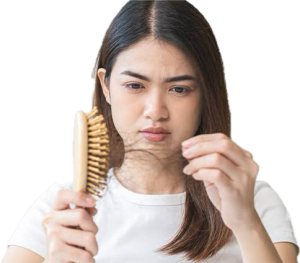Hair loss can occur for various reasons, with some types being common and others rarer, each with distinct underlying causes. Depending on the type, hair loss may result from genetics, internal factors, or external influences. Here’s a breakdown of different types of hair loss:
Androgenic Alopecia
Androgenic alopecia, commonly known as hereditary hair loss, includes male and female pattern baldness and affects up to 50% of people. This type of hair loss occurs gradually and is most common in men, who often experience thinning above the temples and at the crown, forming an “M” shape. Women typically experience overall thinning across the scalp, often noticeable around the part. While it can start as early as puberty, symptoms often emerge in middle age or later.
Alopecia Areata
Alopecia areata is an autoimmune condition where the immune system attacks hair follicles, leading to patchy bald spots that can vary in size and may cause complete hair loss. This condition can also affect hair on other parts of the body, such as eyebrows and eyelashes.
Anagen Effluvium
Anagen effluvium is characterized by rapid hair loss, often due to radiation or chemotherapy treatments. Hair typically regrows once treatment ends.
Telogen Effluvium
Telogen effluvium is sudden hair loss triggered by emotional or physical shocks, such as trauma, extreme stress, or serious illness. Hormonal changes like childbirth, menopause, and conditions such as Polycystic Ovary Syndrome (PCOS) can also cause this type of hair loss. Other potential triggers include malnutrition, endocrine disorders, medication changes, surgery, and acute illnesses like COVID-19. This type usually resolves once the underlying cause is treated.
Tinea Capitis
Tinea capitis, or ringworm of the scalp, is a fungal infection that causes scaly, itchy bald patches that can expand and become filled with pus if untreated. Symptoms include brittle hair, scalp tenderness, and discolored patches. It’s treatable with antifungal medications.
Traction Alopecia
Traction alopecia is caused by excessive tension on the hair, often from tight hairstyles like braids, ponytails, or buns.

